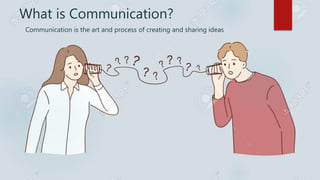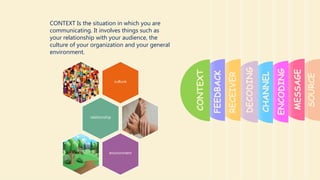SESSION 1 INTRODUCTION TO COMMUNICATION.pptx
- 1. ACTIVITIES
- 3. Learning Outcome At the end of this session, students will be able to: Identify definition of communication and communication skills Implement the process of communication Recognize their own basic personality.
- 4. WHY IT IS IMPORTANT ?? Helps communicate with effective speaking and writing Enhance ability of problem-solving Helps in better decision making Helps maintain good relationship Creates smooth and clean workflow Reflect better professional image Develops self- esteem and confidence Enhance possibility of success
- 5. What is Communication? Communication is the art and process of creating and sharing ideas
- 6. What are communication skills? Communications skills are tools that we use to remove the barriers to effective communication
- 7. SOURCE MESSAGE ENCODING CHANNEL DECODING RECEIVER FEEDBACK CONTEXT COMMUNICATION PROCESS composed of several stages, each of which offers poten barriers to successful communication
- 8. SOURCE MESSAGE ENCODING CHANNEL DECODING RECEIVER FEEDBACK CONTEXT SOURCE of the message is the messenger. The sender must know why the communication is necessary and what result is needed
- 9. SOURCE MESSAGE ENCODING CHANNEL DECODING RECEIVER FEEDBACK CONTEXT MESSAGE is the information that you want to communicate. If you cannot summarize information that you need to share, you aren’t ready to begin the process of communication.
- 10. SOURCE MESSAGE ENCODING CHANNEL DECODING RECEIVER FEEDBACK CONTEXT ENCODING is the process of taking your message and transferring it into proper format for sharing it with your audience. It requires knowing your audience and ensuring that your message provides all of the information that they need.
- 11. SOURCE MESSAGE ENCODING CHANNEL DECODING RECEIVER FEEDBACK CONTEXT The CHANNEL is the method of communication that you choose such as face to face, by telephone, or via email
- 12. SOURCE MESSAGE ENCODING CHANNEL DECODING RECEIVER FEEDBACK CONTEXT DECODING is the process of receiving the message accurately and requires that your audience has the means to understand the information you are sharing
- 13. SOURCE MESSAGE ENCODING CHANNEL DECODING RECEIVER FEEDBACK CONTEXT You have expectations for a response from the receiver when you send a message. You can increase the chances of getting this result by addressing your audience’s concerns or addressing specific benefits as part of your communication
- 14. SOURCE MESSAGE ENCODING CHANNEL DECODING RECEIVER FEEDBACK CONTEXT FEEDBACK let you gauge how successful you were at communicating. It also offers chance to adjust your communication process for the future.
- 15. SOURCE MESSAGE ENCODING CHANNEL DECODING RECEIVER FEEDBACK CONTEXT culture relationship environment CONTEXT Is the situation in which you are communicating. It involves things such as your relationship with your audience, the culture of your organization and your general environment.














